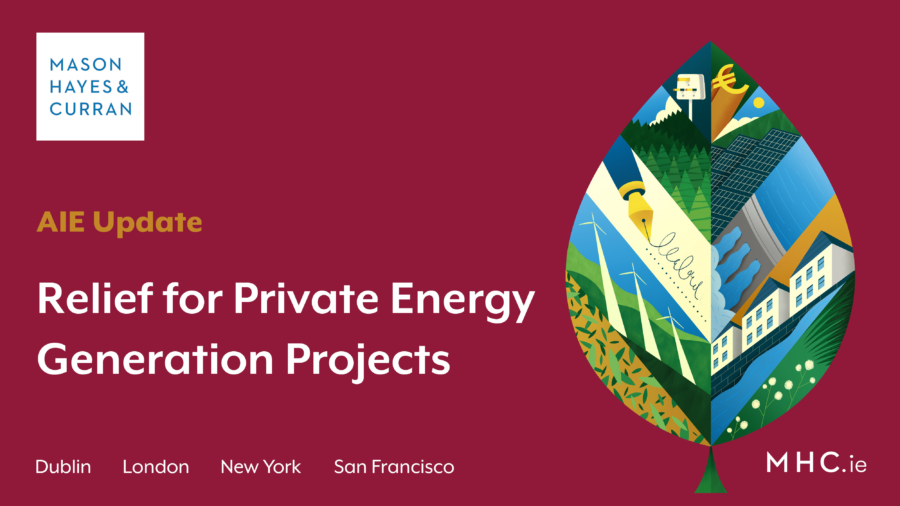
In January 2021, the High Court determined that Raheenleagh Power DAC (RP),
a private energy generation project, was subject to the European Communities (Access to Information on the Environment) Regulations 2007 (AIE Regulations). This was because it satisfied the definition of a “public authority” under that legislation.
Our previous article looked at the implications of this case[1] and its considerable significance for the renewable energy industry. In summary, it meant that “environmental information” held by or for RP, and other similar private energy generation projects, was within the scope of the legislation. As a result, this information was subject to a statutory right of access.
Overturned
The High Court’s decision has now been overturned by the Court of Appeal (CoA). It found that RP is not a ‘public authority’ for the purposes of the AIE Regulations. This is welcome news for many parties in the renewable energy industry, as they are no longer subject to the administrative burden associated with being an AIE public authority and all that it entails. We take a closer look at the CoA’s decision below.
The sole point for determination by the CoA was whether RP is a “public authority” within the meaning of the AIE Regulations. There are three limbs to this definition, the following two of which are relevant here:
- any natural or legal person performing public administrative functions under national law, including specific duties, activities or services in relation to the environment; and
- any natural or legal person having public responsibilities or functions, or providing public services, relating to the environment under the control of [another public authority].
The High Court held that RP fell within both of these parts of the definition:
- Having been authorised to construct and operate an electricity generator, RP was entrusted with the performance of services of public interest and was vested with special powers over and above those that would apply to other private entities, and
- RP was also under the control of ESB Wind, who itself was a public authority under part (b) of the definition.
Questions and answers
The key questions and findings of the CoA were as follows:
Was RP entrusted with the performance of services of public interest?
The CoA found that RP has no responsibility for the generation of electricity. RP is permitted by licence to generate electricity, but it is not obliged or required by law to do so. This is inconsistent with the performance of a public function or the provision of a service of public interest. The changes to the supply of electricity, in particular the supply of electricity to the wholesale market, meant that the activity did not amount to the performance of services of public interest.
Was RP vested with special powers?
The CoA agreed with the High Court that RP had been vested with “special powers” over and above those that would apply to other private entities. These included the ability to CPO private property rights in order to deliver electricity infrastructure in the public interest, which are also known as the ‘step in rights’ and which ordinarily reside with the ESB. However, this is not sufficient to bring it within the scope of part (b) of the “public authority” definition.
Was RP under the “control” of another public authority?
The CoA also agreed with the High Court that the fact RP was a commercial entity did not mean that it could not be “under the control” of another AIE public authority. The test is whether or not the entity acts in a genuinely autonomous manner when performing functions vested in it in the environmental field and whether a public authority is in a position to exert decisive influence upon its action in the environmental field.
However, the CoA disagreed with the High Court’s finding that RP was under the control of ESB Wind. It is necessary to show that the other public authority has had an actual impact on the entity’s decision-making. The issue was one of fact, and the question of whether RP determined the performance of its functions in a genuinely autonomous manner had not been determined by the Commissioner for Environmental Information in his decision. Therefore, there were no findings of fact to underpin the High Court’s finding in this regard.
In light of the above, the CoA found that RP is not a ‘public authority’ under the AIE Regulations.
Conclusion
At the time of writing, it is not clear whether the underlying AIE requester, Right To Know CLG, intends to appeal the CoA’s decision. As things stand, private energy generation projects and Independent Power Producers are no longer subject to the AIE Regulations. Therefore, the scope of the AIE Regulations has been significantly curtailed. This bucks the trend of recent AIE case law, which has significantly expanded the scope of the legislation, namely due to increasingly wide interpretation of “environmental information”.
For more information, please contact a member of our Public, Regulatory & Investigations team.
The content of this article is provided for information purposes only and does not constitute legal or other advice.
[1] Right to Know CLG v Commissioner for Environmental Information and Raheenleagh Power DAC
Share this:


